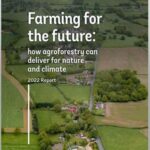As helpfully explained by the LWA in their Agroforestry booklet:
Agroforestry is a new term to some people, but it is a very old practice. People have of course been using trees in agriculture for thousands of years and the history of the UK is full of agroforestry. Examples include:
- Orchards with sheep or poultry grazing underneath.
- The ancient art of pannage where pigs were put into woods to fatten on acorns in the autumn.
- Using trees as a shelter belt to protect crops and livestock.
- Our venerable wood pasture systems, with veteran trees in grazed meadows or parks, which are home to some of our rarest species and are some of our most precious habitats – these are also examples of agroforestry.
- And hedgerows too, providing shelter and secure boundaries – the list goes on.
But it is also ‘new’ because recent years have seen an upsurge in people looking for ways to create more sustainable and nature-friendly farming systems by integrating trees into field crops or pasture systems.
Faced with the reality that conventional, high input farming systems are leading to a loss of species, a climate crisis, a loss of farmers themselves and a huge burden on the environment, interest in agroforestry in the last two years has soared.
And these trials, whether commercially minded or not, have given us plenty of evidence to learn from. This resurgence has been coupled with the ability to learn from examples and farms across Europe and the world, vastly increasing the pool of evidence we can draw on.
- Silvo-pasture – trees with animals, whether that’s sheep, cattle, poultry or others
- Silvo-arable – trees with field scale crops , particularly grain crops
- Silvo-horticulture – trees with market gardens and fruit and vegetable crops on a smaller scale
- Forest farming – a tree dominated system where the
emphasis is on the trees producing the desired crops
themselves.
Of course, all of these could feature on one farm, and can be mixed at different scales and tree densities and tree varieties. One of the beauties of agroforestry is that it is so versatile and can be adapted to the local climate and ecology and markets, wherever it is.
Or this from the Woodland Trust


Or download the Soil Association Manual here
To learn more about the upscaling of agroforestry, visit AGROMIX Project.
In its January 2023 announcement of its new funding schemes for England, DEFRA said this:
Agroforestry (including silvoarable and silvopastoral systems) is the integration of trees into productive areas of a farm, while maintaining the farm’s main agricultural output. The practice is currently limited across England, and on-farm trees are generally planted in marginal, unproductive areas. Through agroforestry, the full gamut of benefits trees provide can support a farm’s productive areas, such as improving soil health, providing shade and shelter for livestock, and creating new habitats for birds and insects. Together, these can support the overall resilience of a farming business.
